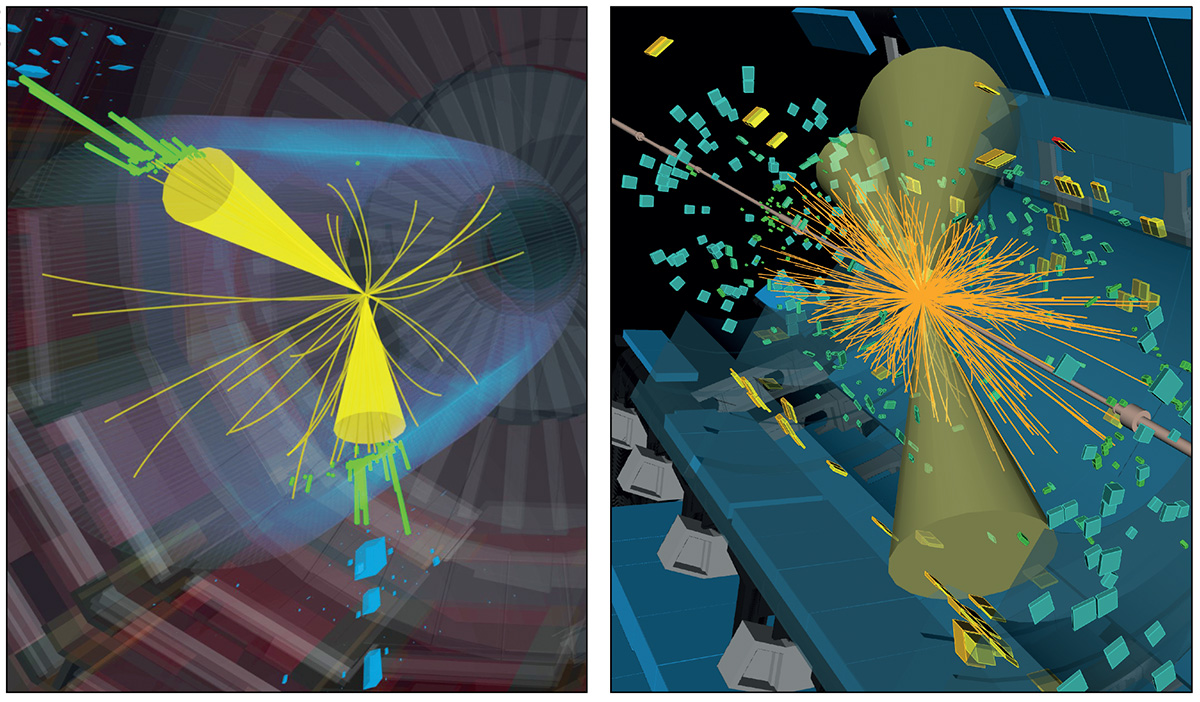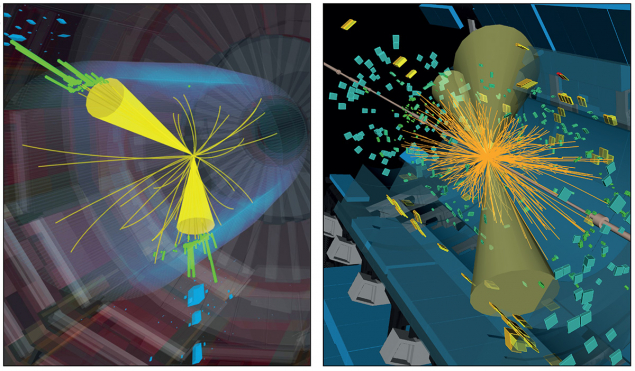Uncharted territory An oxygen–oxygen collision in the CMS detector (left) and a neon–neon collision in the ATLAS detector (right). Credits: CMS; ATLAS
In the first microseconds after the Big Bang, extreme temperatures prevented quarks and gluons from binding into hadrons, filling the universe with a deconfined quark–gluon plasma. Heavy-ion collisions between pairs of gold (19779Au79+) or lead (20882Pb82+) nuclei have long been observed to produce fleeting droplets of this medium, but light–ion collisions remain relatively unexplored. Between 29 June and 9 July 2025, LHC physicists pushed the study of the quark–gluon plasma into new territory, with the first dedicated studies of collisions between pairs of oxygen (168O8+) and neon (2010Ne10+) nuclei, and between oxygen nuclei and protons.
“Early analyses have already helped characterise the geometry of oxygen and neon nuclei, including the latter’s predicted prolate ‘bowling-pin’ shape,” says Anthony Timmins of the University of Houston. “More importantly, they appear consistent with the onset of the quark-gluon plasma in light–ion collisions.”
As the quark–gluon plasma appears to behave like a near-perfect fluid with low viscosity, the key to modelling heavy-ion collisions is hydrodynamics – the physics of how fluids evolve under pressure gradients, viscous stresses and other forces. When two lead nuclei collide at the LHC, they create a tiny, extremely hot fireball where quarks and gluons interact so frequently they reach local thermal equilibrium within about 10–23 s. Measurements of gold–gold collisions at Brookhaven’s RHIC and lead–lead collisions at the LHC suggest that the quark–gluon plasma flows with an extraordinarily low viscosity, close to the quantum limit, allowing momentum to move rapidly across the system. But it’s not clear whether the same rules apply to the smaller nuclear systems involved in light–ion collisions.
“For hydrodynamics to work, along with the appropriate quark-gluon plasma equation of state, you need a separation of scales between the mean free path of quarks and gluons, the pressure gradients and overall system size,” explains Timmins. “As you move to smaller systems, those scales start to overlap. Oxygen and neon are expected to sit near that threshold, close to the limits of plasma formation.”
Across the oxygen–oxygen and neon–neon datasets, the ALICE, ATLAS and CMS collaborations decomposed the transverse distribution of emitted particles into Fourier modes – a way to search for collective, fluid-like behaviour. Measurements of the “elliptic” and “triangular” Fourier components as functions of event multiplicity support the emergence of a collective flow driven by the initial collision geometry. The collaborations observe signs of energetic-probe suppression in oxygen–oxygen collisions – a signature of the droplet “quenching” jets in a way not observed in proton–proton collisions. Similar features appeared in a one-day xenon–xenon run that took place in October 2017.
These initial results are just a smattering of those to come
CMS compared particle yields in light-ion collisions to a proton–proton reference. After scaling for the number of binary nucleon–nucleon interactions, the collaboration observed a maximum suppression of 0.69 ± 0.04 at a transverse momentum of about 6 GeV, more than five standard deviations from unity. While milder than that observed for lead–lead and xenon–xenon collisions, the data point to genuine medium-induced suppression in the smallest ion–ion system studied to date. Meanwhile, ATLAS reported the first dijet transverse-momentum imbalance in a light-ion system. The reduction in balanced jets is consistent with path-length-dependent energy-loss effects, though apparently weaker than in lead–lead collisions.
In “head-on” collisions, ALICE, ATLAS and CMS all observed a neon–oxygen–lead hierarchy in elliptic flow, suggesting that, if a quark–gluon plasma does form, it exhibits the most pronounced “almond shape” in neon collisions. This pattern reflects the expected nuclear geometries of each species. Lead-208 is a doubly magic nucleus, with complete proton and neutron shells that render it tightly bound and nearly spherical in its ground state. Conversely, neon is predicted to be prolate, with its inherent elongation producing a larger elliptic overlap. Oxygen falls in between, consistent with models describing it as roughly spherical or weakly clustered.
ALICE and ATLAS reported a hierarchy of flow coefficients in light-ion collisions, with elliptic, triangular and quadrangular flows progressively decreasing as their Fourier index rises, in line with hydrodynamic expectations. Like CMS’s charged hadron yields, ALICE’s preliminary neutral pion yields exhibit a suppression at large momenta.
In a previous fixed-target study, the LHCb collaboration also measured the elliptic and triangular components of the flow in lead–neon and lead–argon collisions, observing the distinctive shape of the neon nucleus. As for proton–oxygen collisions, LHCb’s forward-rapidity coverage can probe the partonic structure of nuclei at very small values of Bjorken-x – the fraction of the nucleon’s momentum carried by a quark or gluon. Such measurements help constrain nuclear parton distribution functions in the low-x region dominated by gluons and provide rare benchmarks for modelling ultra-high-energy cosmic rays colliding with atmospheric oxygen.
These initial results are just a smattering of those to come. In a whirlwind 11-day campaign, physicists made full use of the brief but precious opportunity to investigate the formation of quark–gluon plasma in the uncharted territory of light ions. Accelerator physicists and experimentalists came together to tackle peculiar problems, such as the appearance of polluting species in the beams due to nuclear transmutation (see “Alchemy by pure light“). Despite the tight schedule, luminosity targets for proton–oxygen, oxygen–oxygen and neon–neon collisions were exceeded by large factors, thanks to high accelerator availability and the high injector intensity delivered by the LHC team.
“These early oxygen and neon studies show that indications of collective flow and parton-energy-loss-like suppression persist even in much smaller systems, while providing new sensitivity to nuclear geometry and valuable prospects for forward-physics studies,” concludes Timmins. “The next step is to pin down oxygen’s nuclear parton distribution function. That will be crucial for understanding the hadron-suppression patterns we see, with proton–oxygen and ultra-peripheral collisions being great ways to get there.”


